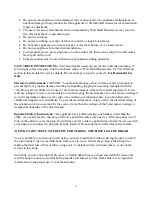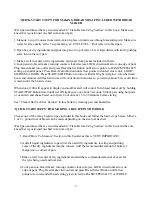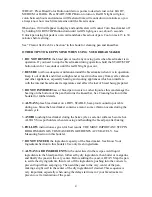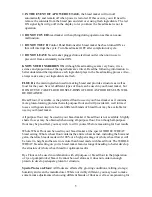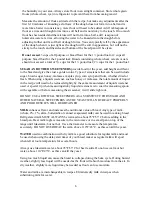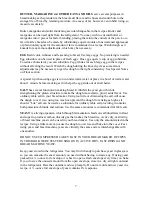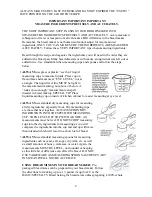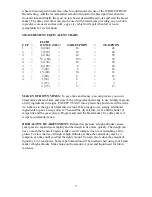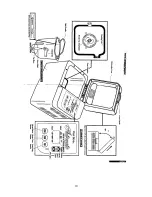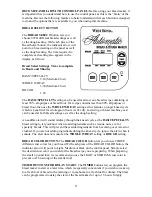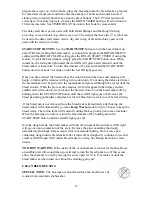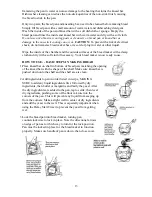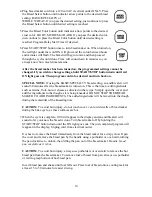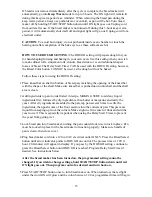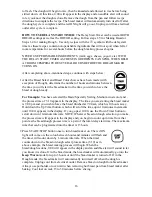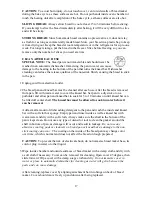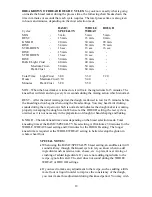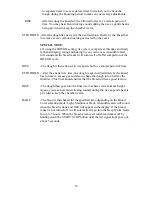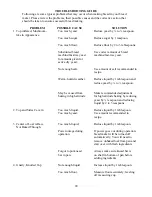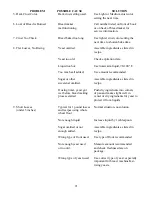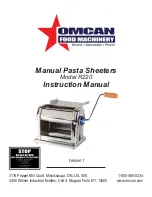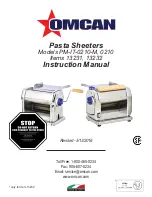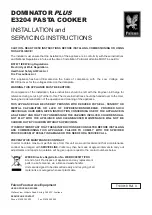
6
the humidity in your area. Always store flour in an airtight container. Store whole grain
flours (whole wheat, rye) in refrigerator to prevent them from becoming rancid.
Measure the amount of flour as directed in the recipe, but make any adjustments after the
first 8-10 minutes of kneading as follows: if the dough does not form into a ball and is
more like a batter in consistency, more flour will need to be added. Add 1 tablespoon of
flour at a time until dough forms into a soft ball and is not sticky to the touch. If too much
flour has been added and the mixture will not form into a ball, add 1 teaspoon of
lukewarm water at a time, allowing the water to be kneaded into the dough before
adjusting further until a soft ball of dough forms. You can typically tell by the appearance
of the dough when it is just right as the dough will be soft in appearance, but will not be
sticky to the touch, and the sides and bottom of the bread pan will be clean.
Do not exceed
3 cups of all purpose or bread flour for the 1½ pound loaf or 2 cups all
purpose bread flour for the 1 pound loaf. Breads containing whole wheat, cereals or oats
should not exceed a total of 3½ cups for the 1½ pound loaf; 2½ cups for the 1 pound loaf.
SUGAR AND OTHER SWEETENERS
provide food for the yeast, add height and flavor
to the bread and give the crust a golden color. Types of sweeteners that can be used include
sugar, brown sugar, honey, molasses, maple syrup, corn syrup and fruits, whether dried or
fresh. When using a liquid sweetener, such as honey or molasses, the total amount of liquid
in the recipe will need to be reduced slightly by the same measurement of liquid sweetener
used. A special tip when measuring sticky liquid sweeteners is to coat the measuring spoon
with vegetable oil before measuring the sweetener; it will slide right out.
DO NOT USE ARTIFICIAL SWEETENERS AS A SUBSTITUTE FOR SUGAR AND
OTHER NATURAL SWEETENERS AS THE YEAST WILL NOT REACT PROPERLY
AND POOR RESULTS WILL BE OBTAINED.
MILK
enhances flavor and increases the nutritional value of bread. Any type of milk
(whole, 2%, 1%, skim, buttermilk or canned evaporated milk) can be used in making bread
Refrigerated milk MUST ALWAYS be warmed to about 95°F/33°C before adding to the
bread pan. Heat milk in glass measure in the microwave or in a small pan on top of the
range until lukewarm, but not hot. Use a thermometer to measure the temperature
accurately. DO NOT OVERHEAT the milk, above 110°F/43°C, as this can kill the yeast.
WATER
used in combination with dry milk is a good substitute for regular milk and must
be used when using the delay start timer of your bread maker as regular milk will spoil
when left at room temperature for several hours.
Always use lukewarm water, about 95°F/35°C for best results. Do not use warm or hot
water, above 110°F/43°C, as this can kill the yeast.
Using too much liquid can cause the bread to collapse during the bake cycle. During humid
weather, slightly less liquid will be needed as the flour will absorb moisture from the air. In
dry weather, slightly more liquid may be needed as flour can lose moisture.
Water and milk are interchangeable in recipes. Eliminate dry milk in recipes when
substituting milk for water.
Summary of Contents for L4805
Page 10: ...10...


